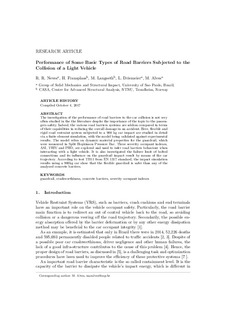| dc.contributor.author | Neves, Renato R | |
| dc.contributor.author | Fransplass, Henning | |
| dc.contributor.author | Langseth, Magnus | |
| dc.contributor.author | Driemeier, Larissa | |
| dc.contributor.author | Alves, Marcilio | |
| dc.date.accessioned | 2019-01-16T07:02:02Z | |
| dc.date.available | 2019-01-16T07:02:02Z | |
| dc.date.created | 2018-11-28T15:00:48Z | |
| dc.date.issued | 2018 | |
| dc.identifier.citation | Journal of the Brazilian Society of Mechanical Sciences and Engineering. 2018, 40 (6), . | nb_NO |
| dc.identifier.issn | 1678-5878 | |
| dc.identifier.uri | http://hdl.handle.net/11250/2580768 | |
| dc.description.abstract | The investigation of the performance of road barriers to the car collision is not very often studied in the literature despite the importance of the topic to the passengers' safety. Indeed, the various road barriers systems are seldom compared in terms of their capabilities in reducing the overall damage in an accident. Here, flexible and rigid road restraint system subjected to a 900 kg car impact is studied in detail via a finite element simulation, with the model being validated against experimental results. The model relies on dynamic material properties for the guardrail, which were measured in Split Hopkinson Pressure Bar. Three severity occupant indexes, ASI, THIV and PHD, are explored and used to infer road barriers behaviour when interacting with a light vehicle. It is also investigated the failure limit of bolted connections and its influence on the guardrail impact result by means of the car trajectory. According to test TB11 from EN 1317 standard, the impact simulation results using a 900 kg car show that the flexible guardrail is safer than any of the analysed concrete barriers. | nb_NO |
| dc.language.iso | eng | nb_NO |
| dc.publisher | Springer Verlag | nb_NO |
| dc.title | Performance of Some Basic Types of Road Barriers Subjected to the Collision of a Light Vehicle | nb_NO |
| dc.type | Journal article | nb_NO |
| dc.type | Peer reviewed | nb_NO |
| dc.description.version | acceptedVersion | nb_NO |
| dc.source.pagenumber | 14 | nb_NO |
| dc.source.volume | 40 | nb_NO |
| dc.source.journal | Journal of the Brazilian Society of Mechanical Sciences and Engineering | nb_NO |
| dc.source.issue | 6 | nb_NO |
| dc.identifier.doi | 10.1007/s40430-018-1201-x | |
| dc.identifier.cristin | 1636533 | |
| dc.relation.project | Norges forskningsråd: 237885 | nb_NO |
| dc.description.localcode | This is a post-peer-review, pre-copyedit version of an article published in [Journal of the Brazilian Society of Mechanical Sciences and Engineering] Locked until 4.5.2019 due to copyright restrictions. The final authenticated version is available online at: https://doi.org/10.1007/s40430-018-1201-x | nb_NO |
| cristin.unitcode | 194,64,45,0 | |
| cristin.unitname | Institutt for konstruksjonsteknikk | |
| cristin.ispublished | true | |
| cristin.fulltext | postprint | |
| cristin.qualitycode | 1 | |
